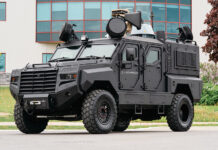A range of Unattended Ground Sensors presented at Eurosatory by several manufacturers, indicated the growing interest in autonomous surveillance and perimeter security, as part of the protection of forward operating bases and deployed forces. Harris and Textron defense are two the established names in this business. Harris offers a comprehensive array of sensors including acoustic, seismic, magnetic, Passive Infrared (PIR) and imagers, and networking devices fully integrated with their Falcon II radios, meaning that a deployed unit can rely on their existing tactical radio network to control their unattended security network. Harris recently announced that the Royal Netherlands Air Force acquired such systems as part of the RNLAF Transportable Intrusion Detection System (TIDS) protecting their forces deployed in Afghanistan.
Textron Systems is developing the Tactical Unattended Ground Sensor (T-UGS) and Urban UGS (U-UGS) families of sensors as part of the U.S. Army’s FCS program. T-UGS is used as a rapidly deployable sensor unit, each equipped wit multi-modal sensors to detect vehicles, personnel and aircraft and act as an ISR network node. The T-UGS unit also has built-in controller performing initial signal processing target classification and determining bearing to the target, offering false target rejection. Additional situational awareness features of the T-UGS include Chemical, Radiological and Nuclear (CRN) early warning detection/marking as well as marking cleared lanes through obstacles and hazards by employing Hazard Clearing Lane markers (HLCM). Both CRN and HLCM missions provide warning signals to approaching manned and unmanned systems to ensure safe passage.
Elta also introduced a new range of unattended ground sensors network (USGN) as part of its EL/I-6001 tactical intelligence and recce collection capability. This modular network of autonomous, distributed sensors includes seismic, acoustic and electro-optical sensors and miniature ground surveillance radars. Each sensor comprises a sensitive microphone for acoustic detection, a geophone to pick-up seismic vibration from nearby movement, a GPS receiver, communications transceiver and low-power controller and signal processor. The sensor can pick up moving heavy vehicles (such as tanks) from a distance of 500 meters and walking humans from 50 meters. These sensors can operate autonomously or in combination, optimizing area coverage, and facilitating target detection, classification. To save power, the EO sensors are maintained ‘dormant’, activated only when other sensors UGS confirm a target is in sight.
Specializing in the seismic domain, Spydertech, an Israeli company specializing in security applications of seismic monitoring systems unveiled at Eurosatory a 3D seismic surveillance system capable of accurately detecting and tracking movement underground and on the surface. The new system based on proprietary sensors and hardware developed specifically for underground applications. The system comprised of up to 250 sensors, each performing signal processing at the sensor, contributing to high probability of target detection with low rate of false alarms.
In addition, the system can detect subterranean activity at depths of 35 meters. Another type of virtual fens is developed by Magna BSP. These systems are already being deployed operationally as part of perimeter security systems with further work and customer evaluations done with tactical, deployable systems, supporting ad-hoc protection of forward operating bases and deployed forces. Utilizing both FLIR and CCD sensors, enabling automatic switching between sensors when visibility conditions are reduced/ The sensors are staring at the same time and position at the same field of view thus contributing to the system’s low false alarm rate. These systems demonstrated less than one False Alarm Rate over 24 hours (FAR/24) while detecting 100% of targets at the zone of interest.
Controp have shown the Spider thermal area scanner at Eurosatory, a system currently being employed for border protection by the Israel Defense Forces. The system’s sensors and command and control console were on display, showing the system’s capability to cover wide area of interest, track suspicious targets and provide target data Spider and relevant close-up images in real-time.
The following topics are included in our Eurosatory 2008 focus:
-
Force Protection with Unattended Ground Sensors
- Unmanned Aerial and Ground Systems (UAV/UGV)


















